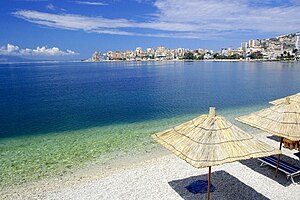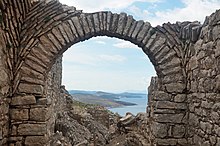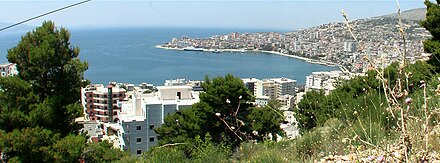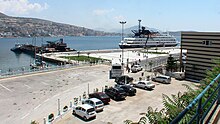Saranda
|
Sarandë Saranda |
||

|
||
|
Coordinates: 39 ° 53 ' N , 20 ° 1' E |
||
| Basic data | ||
|---|---|---|
| Qark : | Vlora | |
| Municipality : | Saranda | |
| Height : | 75 m above sea level A. | |
| Area : | 58.96 km² | |
| Residential place : | 17,233 (2011) | |
| Bashkia residents : | 20,227 (2011) | |
| Population density (Bashkia): | 343 inhabitants / km² | |
| Telephone code : | (+355) 0852 | |
| Postal code : | 9701-9703 | |
| Politics and administration (as of 2019 ) | ||
| Mayor : | Adrian Gurma ( PS ) | |
| Website : | ||
| Culture and history | ||
| City Festival : | 10th of May | |
 Saranda Skyline and Bay (2009) |
||
Saranda ( Albanian also Sarandë ; Greek Άγιοι Σαράντα Ágioi Saránta ; Italian Santi Quaranta ) is a port city in the extreme south of Albania with around 17,500 inhabitants (2011 census). Saranda is a popular seaside resort on the Ionian Sea not far from the Greek island of Corfu .
geography
Saranda is located on a small, not particularly protected bay that is open to the south and is surrounded by hills that are 200 to 400 meters high. From here it is only a few kilometers to the southwestern Greek island of Corfu. The city is separated from the fertile plain in the east by a narrow range of hills, which stretches south to the Vivar Canal at Butrint , which is almost 20 kilometers away, and rises north of the city to 600 meter high mountains. On the Mali i Lëkurësit , which is part of this range of hills and is located southeast of the city center, a castle was built in the Middle Ages (called Kalaja e Lëkurësit ). On a hill further north, above the city, stand the ruins of the Convent of the Forty Martyrs .
Since 2015, the former municipality ( komuna ) Ksamil (2994 inhabitants) on the peninsula south between Lake Butrint and the sea has also belonged to the municipality ( bashkia ) Saranda. The new municipality has 20,227 inhabitants (as of 2011).
The small town of Delvina is located 15 kilometers inland to the northeast of Saranda . The Albanian Riviera begins in the north .
population
The city of Saranda with the surrounding villages of Gjashta , Metoq , Çuka and Shelegar has 17,233 inhabitants (2011 census). A decreasing proportion of them belong to the Greek minority : while in 1990 around 7,500 people belonged to the Greek minority, a little more than ten years later the figure was around 3,500. This development is due to economic migration movements: ethnic Greeks were more easily able to obtain residence permits in the neighboring country which accelerated their exodus. Many Saranda residents also moved to the capital Tirana .
history
In ancient times the place was called Onchesmos and served mainly as the port of Phoinike . Various remains from late antiquity such as the city wall can still be seen in the city center today. These include the remains of a large synagogue , evidence of the millennia-long presence of Jews in Albania . In the 6th century the “huge church” ( Guntram Koch ) of the “Monastery for the Forty Martyrs ” was built above the city , probably a place of pilgrimage with a large crypt . The current name Saranda is derived from its Greek name Hagioi Saranta . Later, the Italian version Santi Quaranta became increasingly popular . The ruins of the basilica , which the archaeologist Luigi Maria Ugolini was still studying in the late 1930s, were completely destroyed by an air raid during World War II .
Like Butrint , Saranda was destroyed during the Great Migration in 551. In the Middle Ages, the port city was usually of little importance and was repeatedly destroyed and looted. From the beginning of the 15th century Saranda was part of the Ottoman Empire for almost 500 years , belonged to the “ Sanjak of Delvina” and experienced a decline. In 1878 Greek nationalists from Corfu burned the city down.
During the First Balkan War in 1912, Greek troops occupied the place. Because of the Greek minority, the Athens government claimed Saranda and other cities in the south and south-east of Albania ( Northern Epirus ) for Greece. The great European powers exerted diplomatic pressure on the Greeks, who eventually evacuated Saranda in early 1914 and the place was united with Albania. Saranda had only 110 inhabitants in 1913. During the First World War , the small village served as a military port for the Italian Navy from 1916 to early 1919 .
In the interwar period, the population increased rapidly. Before the Second World War the Albanians called the place Pirro , during eight months after the Albanian King Zogu it was also called Zogaj . On Good Friday 1939, Saranda was one of the landing sites of the Italian troops who occupied Albania for Fascist Italy in order to realize Benito Mussolini's imperial plans . During the Italian occupation , the port was named Porto Edda after Mussolini's daughter .
After the failed Italian attack on Greece at the beginning of the Second World War, the Greeks went on the counter-offensive in the winter of 1940 and occupied Saranda on December 6th. In October 1944, 1200 British marines landed on the coast north of Saranda to fight the German troops in the area. The communist partisans had already surrounded Saranda and were demanding that the British leave Albanian territory again. During the fighting for the city, the remains of the Convent of the Forty Martyrs were destroyed. In 1945 there were 1520 inhabitants.
From the mid-1950s, under the dictatorship of Enver Hoxha , Saranda was developed into a holiday destination and expanded significantly. Some factories, especially for the food industry, were also built. Many farms were built on the eastern plain. It was only at this time that the place got an urban character. In 1967 there were 8,700 inhabitants in the city.
After the fall of the dictatorship in 1990/91, most of the factories were closed, and as a result unemployment and poverty rose. During the 1997 lottery riot, rioters broke into the city's three museums (education, weapons and ethnography), robbed them and set them on fire. The remains can be seen in the small exhibition Museu i Traditës at the port.
tourism
Beach tourism has become the most important branch of the population for the last 20 years . The city's guests are mostly Albanians. In the last few years tourism development has triggered a building boom. Numerous hotels and also buildings with holiday apartments were built. The place is expanding more and more into the previously undeveloped surrounding area. As a result, Saranda has lost much of its former charm of a small coastal town. Since 2013, illegally constructed buildings and objects have been demolished as part of the program of the new Rama government .
The most important sights in Saranda are the extensive ancient ruins of Butrint about 15 kilometers south of the city, a UNESCO World Heritage Site since 1992 . Other sights are the Byzantine church Shën Kollë ( dedicated to Nicholas of Myra ) in Mesopotam and Syri i Kaltër ( Blue Eye ), the most famous karst spring in Albania. The ancient site of Phoinike east of the city near Finiq is also a notable sight. In 2006 a theater was excavated there.
Saranda is visited by around 500,000 tourists annually. 35 percent of them are not from Albania or Kosovo .
traffic
Located in the very south of Albania and surrounded by a mountainous hinterland, Saranda is only slightly connected to the country's centers. A bus trip via Gjirokastra to the capital Tirana (approx. 270 kilometers) takes around four hours. The winding coastal road along the Albanian Riviera ( SH8 ) via Himara to Vlora has been renewed. It takes about two hours for the 120 kilometers. Most of the traffic to and from Saranda continues over the 572 meter high Qafa e Muzinës pass (SH99), which is an important link with the Drino Valley and the well-developed SH4 ( north-south corridor ). This 33-kilometer section from Saranda to Jorgucat was renewed in 2007. Another, small border crossing to Greece is in the south near Konispol ; it is around 35 kilometers to this limit.
Ferries and hydrofoils to Saranda run daily from Corfu. Especially in summer, many foreign day tourists come to Albania by ship. Cruise ships use the port so their passengers can visit Butrint. In the high season hydrofoils also run to Himara and Vlora .
The port's importance as a goods transshipment point for Albania is very low: in 2004, goods turnover was only 73,400 tons. The Albanian Navy operates a base there .
Personalities
- Hasan Tahsini (1811–1881), politician
- Kiço Mustaqi (1938–2019), politician
Web links
- Official website of the municipality (Albanian)
- Visit Saranda
- SarandaWeb (news portal; Albanian)
- Saranda Harbor (Albanian)
- Le false sovrastampe di SANTI40, Notes on the Postal History of Saranda (Italian)
Individual evidence
- ↑ a b c d Ines Nurja: Results of the 2011 census for the Qark Vlora. In: Instituti i Statistics . Accessed April 14, 2019 (English, PDF file, 1.59 MB).
- ↑ Tabelat me 61 bashkitë (njesitë administrative përbërëse dhe fshatrat). (PDF) In: Reforma Administrative Territoriale. Retrieved November 10, 2015 (Albanian).
- ^ On the Status of the Minorities in the Republic of Albania. (No longer available online.) In: Albanian Helsinki Committee. Archived from the original on September 3, 2014 ; accessed on May 7, 2014 (English, PDF file; 41 kB). Info: The archive link was inserted automatically and has not yet been checked. Please check the original and archive link according to the instructions and then remove this notice.
- ^ Wolfgang Stoppel: Rights and protection of national minorities in Albania . K&B, Tirana 2003, ISBN 99927-777-9-6 .
- ↑ Guntram Koch: Albania . Cologne 1989, ISBN 3-7701-2079-5 .
- ↑ Peter Bartl: Albania. From the Middle Ages to the present . Regensburg 1995, ISBN 3-7917-1451-1 .
- ↑ James Pettifer: Albania & Kosovo . London 2001, ISBN 0-7136-5016-8 .
- ^ A b Julie Vullnetari: Albanian Migration and Development: State of the Art Review . IMISCOE Working Paper. Falmer 2007 ( PDF [accessed May 7, 2014]).
- ↑ a b Fatos Baxhaku: Saranda: Çelësi turistik . Tirana 2006, ISBN 978-99943-964-5-0 .
- ↑ Oliver Gilkes: Albanian - An Archaeological Guide . IB Tauris, London 2013, ISBN 978-1-78076-069-8 , Saranda, pp. 255 ff .
- ↑ Muzeu i traditës në Sarandë. In: Top Channel . January 10, 2014, accessed January 10, 2014 (Albanian, title: Museum of Tradition in Saranda ).
- ↑ Saranda prezantohet në Prishtinë. In: Top Channel . May 6, 2014, accessed November 10, 2015 (Albanian).




